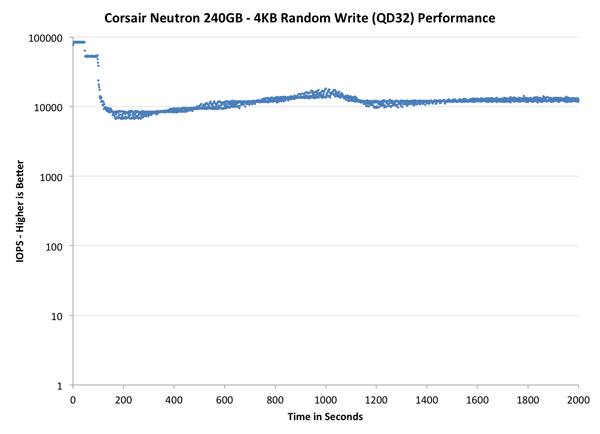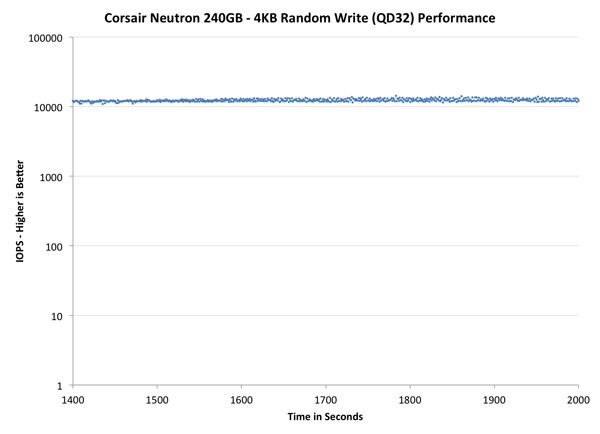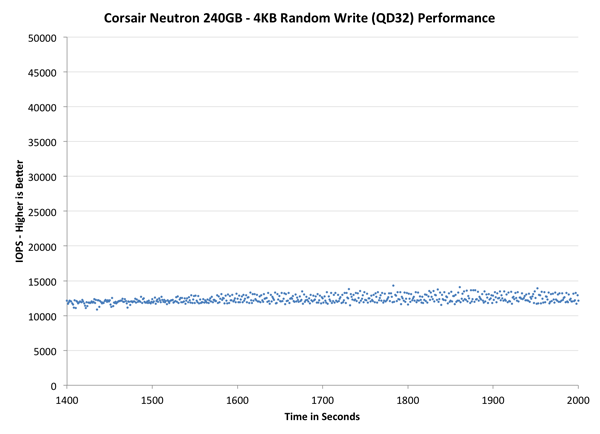Corsair Neutron & Neutron GTX: All Capacities Tested
by Kristian Vättö on December 19, 2012 1:10 PM ESTPerformance Consistency
If you read our Exploring the Relationship Between Spare Area and Performance Consistency in Modern SSDs article, you have seen the performance consistency data for Neutron already and the data here should be nothing new. However, because we didn't have any performance consistency results in our initial Neutron review, I wanted to focus on it here.
We started paying attention to performance consistency when Intel launched the DC S3700 because Intel specifically highlighted its low latencies, which translate to consistent performance. Consistency has been a big selling point in the enterprise market for a long time now, but that has not yet transferred to the consumer SSD market. Given LAMD's enterprise focused history, I was eager to find out how the LM87800 would do in this regard.
To generate the data below I took a freshly secure erased SSD and filled it with compressible sequential data (incompressible for Intel SSD 335) . This ensures that all user accessible LBAs have data associated with them. Next I kicked off a 4KB random write workload at a queue depth of 32 using incompressible data. I ran the test for just over half an hour, no where near what we run our steady state tests for but enough to give me a good look at drive behavior once all spare area fills up.
I recorded instantaneous IOPS every second for the duration of the test. I then plotted IOPS vs. time and generated the scatter plots below. Each set of graphs features the same scale. The first two sets use a log scale for easy comparison, while the last set of graphs uses a linear scale that tops out at 40K IOPS for better visualization of differences between drives.
The first set of graphs shows the performance data over the entire 2000 second test period. In these charts you'll notice an early period of very high performance followed by a sharp dropoff. What you're seeing in that case is the drive alllocating new blocks from its spare area, then eventually using up all free blocks and having to perform a read-modify-write for all subsequent writes (write amplification goes up, performance goes down).
The second set of graphs zooms in to the beginning of steady state operation for the drive (t=1400s). The third set also looks at the beginning of steady state operation but on a linear performance scale. Click the buttons below each graph to switch source data.

The Neutron is extremely consistent. After the first burst, the performance variation is very small compared to for example OCZ Vector and Samsung SSD 840 Pro, although it should be noted that the Neutron comes with 12% over-provisioning by default while Vector and 840 Pro have only 7% of the capacity reserved for OP. The amount of OP can have an enormous effect on consistency but if that extra consistency is only due to the extra OP Corsair and LAMD has set aside, then it's been a great decision. Out of the consumer-grade drives, only Intel SSD 335 is more consistent but SandForce has always performed well when it comes to steady-state performance.

When focusing on the last 10 minutes of the test where most SSDs have reached steady state, the Neutron is exceptional. While all other SSDs in this test including the enterprise focused Intel S3700 have noticeably variation in IOPS, the Neutron does not. The variation is only around 2-3K IOPS, whereas for Intel SSD 335 it's up to 25K IOPS. The steady state performance in general is also great; Vector and 840 Pro have an average IOPS of ~5-8K while the Neutron manages to push 12-13K IOPS. Intel DC S3700 is obviously in its own class but again, keep in mind that it also has significantly more OP than the other SSDs in this test. When the Neutron is given about as much OP as the S3700, they perform about the same.

Neutron's ability to retain performance and consistency over time is definitely appreciated and it's the most consistent consumer-grade SSD at the default OP we have tested. SandForce based SSDs can push much higher peak IOPS but the variation is in the magnitude of tens of thousands of IOPS. While the SSD 335 has higher IOPS on average, it drops below 10K right after 30 minutes of 4KB random writes but the Neutron is able to sustain a throughput of 12-13K throughout the last ten minutes of the test.










44 Comments
View All Comments
Sabresiberian - Wednesday, December 19, 2012 - link
Always glad to see someone step in with a different controller than the majority have, and see it perform very well. Good job Corsair!I have to say, the price/performance is excellent and I'm very tempted to replace the 840 Pro as the choice for my next build. That being said, what I really hope it does at this point is cause Samsung to drop the price of the 840 Pro lineup.
extide - Wednesday, December 19, 2012 - link
I wouldn't expect much of any change-up in the market as these drives have already been out for a few months. They are not brand new at this point.Sabresiberian - Thursday, December 20, 2012 - link
Heh well I wasn't implying there would or even should be any kind of change-up, I'm just saying I want competition to stay alive as long as possible, and if everyone jumps onto one controller from one source the only competition point will more rapidly come down to just price.The differences are basically controller, NAND, and price, in today's consumer market, and frankly I'd like to see controllers in particular get a lot better. They are good at pumping out high peak numbers, but consistency and even reliability just aren't there yet, in my opinion. (I mean reliability in terms of getting a bug-free controller, not in terms of life of the SSD.)
Flying Goat - Thursday, January 3, 2013 - link
Hmmm...The Samsung 840 Pro 512GB has dropped by at least $100 in the past month. Not making any claims about the reason for that.Drazick - Wednesday, December 19, 2012 - link
Hi,Why don't you update your Google+ Page?
Thank You.
nathanddrews - Thursday, December 20, 2012 - link
What's Google+?Snotling - Thursday, December 20, 2012 - link
google it, you'll know.Sabresiberian - Thursday, December 20, 2012 - link
Google+ is an even less secure version of Facebook.If you like Google laying claim to every word you say, then by all means sign up for it.
blanarahul - Wednesday, December 19, 2012 - link
When are you going to review lower capacity models of 840 Pro and 840?Nice review though.
Kristian Vättö - Thursday, December 20, 2012 - link
I have a 128GB and 512GB 840 Pros but we are still waiting for additional 840 capacities.